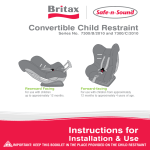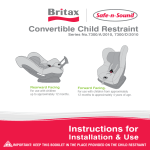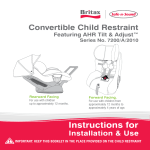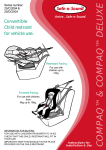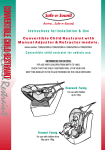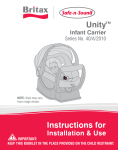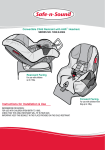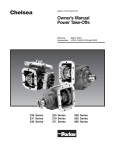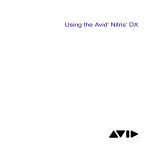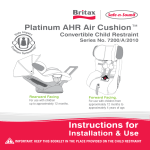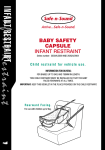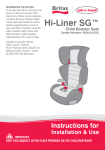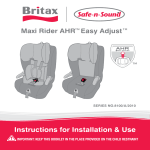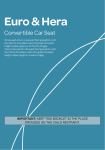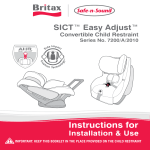Download Britax Baby-Safe Owner`s manual
Transcript
Baby Safety Capsule Series number: 2030/A/2010 FOR BABIES UP TO APPROXIMATELY 6 MONTHS OR WHO HAVE NOT YET REACHED THE SHOULDER HEIGHT MARKER. THIS INFANT CARRIER MUST BE INSTALLED SO THAT THE BABY IS REARWARD-FACING AT ALL TIMES. IMPORTANT: KEEP THIS BOOKLET IN Instructions THE PLACE PROVIDED ON THE CHILD RESTRAINT. for Installation & Use - Series number: 2030/A/2010 INDEX INTRODUCTION Page To be used only in a rearward-facing position for an infant until their shoulders reach the shoulder height marker (approximately 6 months of age). 3 INTRODUCTION 4 WARNINGS 6 SHOULDER HEIGHT MARKERS AND A GROWING CHILD TO BE USED WITH A LAP-SASH OR LAP-ONLY SEATBELT IN THE BACK OF MOST CARS WITH FORWARD FACING SEATS. 8 SPECIAL FEATURES THIS RESTRAINT IS NOT SUITABLE FOR USE WHERE THE UPPER ANCHORAGE STRAP MAY FALL INTO A SPLIT IN THE SEAT BACK. (E.G. HATCHBACK OR WAGON). 10 SUITABLE FOR USE Continue to use this infant restraint until the child reaches this limit. Infants are at risk of serious injury if they face forward too early. CAREFULLY READ ALL THE INSTRUCTIONS FOR INSTALLATION. IN THE EVENT OF DOUBT ABOUT THE METHOD OF INSTALLATION, CONSULT BRITAX CHILDCARE OR AGENT OR A CHILD RESTRAINT FITTING STATION AUTHORISED BY A RELEVANT TRANSPORT AUTHORITY OR, IN NEW ZEALAND, THE AGENT FOR THE CAR. 13 HOW TO SETUP 21 No child restraint can guarantee absolute protection from injury in every crash. However, to ensure that your child gets all the protection designed into the restraint, PLEASE READ AND FOLLOW THESE INSTRUCTIONS EXACTLY and use only Safe-n-Sound (Britax) recommended parts and accessories. HOW TO INSTALL 24 HOW TO USE 32 SHOULDER HEIGHT MARKERS AND THE NEXT STEP 33 CARE & MAINTENANCE 36 TRAVELLING TIPS 38 INSTALLATION OF CAR ANCHOR FITTING 43 ALTERNATIVE INSTALLATION IF SEATBELT LOOSENS 45 THIS RESTRAINT MUST BE ATTACHED TO A CHILD RESTRAINT ANCHORAGE POINT IN THE CAR. REFER TO CAR OWNER’S HANDBOOK FOR LOCATION OF ANCHORAGE POINTS. REFER TO A CHILD RESTRAINT FITTING STATION IF NO ANCHORAGE POINTS ARE IN THE MOTOR CAR. Britax Childcare Pty. Ltd. continues to provide care for your children when travelling in motor cars with a range of child restraints suitable throughout their childhood. This instruction book can be stored under the cover of the Baby Safety Capsule for future reference. IN CASE OF ACCIDENT 2 Instructions for Installation & Use - Series number: 2030/A/2010 Instructions for Installation & Use - Series number: 2030/A/2010 3 • Use the restraint exactly as shown in the instructions. • Straps may be damaged by unsecured cargo in a collision. Secure or remove hazardous cargo before using this strap. Hatch-back or wagon: Do not use the child restraint where this strap may fall into a split in the seat back. • Fit the restraint firmly to the car seat. • Fit the harness firmly to the child. • A loose restraint or harness is dangerous. • Regularly check the restraint components, straps and other fitments for correct function & condition. Seek prompt repair. • DO NOT LEAVE CHILDREN UNATTENDED IN THE CAR. • Protect all webbing from abrasion and cutting by sharp corners and edges. • Supervision of children is needed because they may be able to undo buckles. • • DO NOT USE A REAR-FACING CHILD RESTRAINT WHERE AN AIRBAG IS FITTED IN FRONT OF THE SEATING POSITION. For other airbags, refer to the car owner’s handbook for warnings and instructions. Upper Anchorage Straps and extension straps may be damaged by unsecured cargo in a collision. Secure or remove hazardous cargo before using this restraint. • • To ensure baby’s back is evenly supported do not put more than one nappy on the baby and make sure the nappy is not thickly folded at the back. The restraint should not be purchased or sold as a second hand item. It is recommended not to use child restraints older that 10 years as the protection in an accident may be reduced. The life will be reduced when used in commercial use. • • Do not alter or modify this restraint. Do not store in areas that may get hot, like in car boots, roof space, beside shed walls which get hot in summer. Do not place heavy items on top of the seat as this may distort the plastic. • Repairs must only be done by the manufacturer or agent. • Do not allow the restraint to come into contact with polishes, oils, bleach and other chemicals. • Destroy the restraint if it has been in a severe crash, even if no damage is visible. • DO NOT USE THIS RESTRAINT WITHOUT THE COVER. • Carry the Carrier using both handles together. • The restraint is not intended to be a substitute baby cot or bed. It is only designed to enable safe transportation of children in motor vehicles. Do not leave a baby in the restraint for long periods of time. 4 Instructions for Installation & Use - Series number: 2030/A/2010 : DO NOT LEAVE CHILDREN UNATTENDED IN THE CAR. Instructions for Installation & Use - Series number: 2030/A/2010 5 SHOULDER HEIGHT MARKERS AND A GROWING CHILD OLDER BABY NEW BABY Shoulder Height Marker Shoulder Height Marker SHOULDER HEIGHT MARKERS AND A GROWING CHILD IMPORTANT: FOLLOW THIS ADVICE. DO NOT MOVE TO THE NEXT RESTRAINT UNTIL THE CHILD’S SHOULDER REACH THE SHOULDER HEIGHT MARKER. When the child’s shoulder reaches this marker, the child is now too big for the Baby Safety Capsule. It is now time to move to the next child restraint. See page 32. FRONT OF VEHICLE The Baby Safety Capsule is not suitable for your child when their shoulders are above the shoulder height marker. If the babies neck muscles are unable to support their head, then the child should remain rear-facing. Choose a child restraint that will take larger babies in rear-facing. DO NOT MOVE TO THE NEXT RESTRAINT UNTIL THE CHILD’S SHOULDER REACHES THE SHOULDER HEIGHT MARKER. 6 Instructions for Installation & Use - Series number: 2030/A/2010 Instructions for Installation & Use - Series number: 2030/A/2010 7 SPECIAL FEATURES SPECIAL FEATURES 17 7 18 19 20 21 9 1 10 2 2 8 8 3 7 4 5 3 16 15 11 14 12 1. Shoulder Slots 2. Carrier 6 3. Cover 4. Harness Adjustment Buckle 5. Harness FRONT OF VEHICLE 12. REARWARD-FACING SEATBELT PATH marker 13. Base 14. Boss Cap 15. Harness Adjuster Strap 6. Harness Crotch Slots 7. Harness Tongue Holders 8. Shoulder Height Marker 8 Instructions for Installation & Use - Series number: 13 9. Anchor Fitting 10. Press Catch 11. Car Seat belt 2030/A/2010 16. 17. 18. 19. 20. 21. Harness Adjuster Upper Anchorage Strap. Upper Anchorage Strap bracket Harness Adjuster Adjustable upper anchorage strap Attachment Clip Instructions for Installation & Use - Series number: 2030/A/2010 9 SUITABLE FOR USE SUITABLE FOR USE TO BE USED WITH A LAP-SASH OR LAP ONLY SEAT BELT IN THE BACK OF MOST CARS WITH FORWARD-FACING SEATS. To be used in a rearward-facing position until the infant’s shoulder’s reach the shoulder height marker (approximately 6 months of age). Continue to use this infant restraint until child reaches this limit. Infants are at risk of serious injury if they face forward too early. If the baby’s neck muscles are unable to support their head, then the child should remain rear-facing in a restraint that is larger, possibly a Convertible child restraint. THE UPPER ANCHORAGE STRAP MUST ALWAYS BE FITTED WHEN THE CHILD RESTRAINT IS USED IN A VEHICLE. Do not use the restraint without the Upper Anchorage Strap correctly attached. The upper anchorage strap must be attached to an anchorage point using an extension strap if necessary. The Baby Safety Capsule must not touch the front seat, as the Base may be deformed in a warm car. Do not recline the seat excessively, it must be installed at the correct angle (see page 20). Do not allow the front seat to contact the Base as the Base may distort in hot cars. 485mm Do not touch seat in front. 545mm Seat Width 440mm To ensure that the space is sufficient, the purchaser should check the measurements between the vehicle’s rear and front seats in which the child restraint is intended to be used. Regional Road Rules may restrict the use of child restraints, like this Baby Safety Capsule, in the front seat of the car. Check your local Road Rules. Do not use on any car seat which faces sideways or rearwards. DO NOT USE A REAR-FACING CHILD RESTRAINT WHERE AN AIRBAG IS FITTED IN FRONT OF THE SEATING POSITION. For other airbags, refer to the car owner’s handbook for warnings and instructions. Seat belt extenders should not be used if the seat belt is not long enough to fit around the child restraint Base. If they are used then the buckle must not enter the Base. 10 Instructions for Installation & Use - Series number: 2030/A/2010 Instructions for Installation & Use - Series number: 2030/A/2010 11 SUITABLE FOR USE HOW TO SET-UP HOW IT WORKS Why can't you see your baby while travelling? Because having their back to you inside the Baby Safety Capsule is the safest way for your baby to travel in a motor vehicle. During an accident, the Baby Safety Capsule wants to continue moving forward. The accident sensitive latch disengages during an accident allowing the Carrier to turn about the pivot. With the Carrier turned the impact forces are more uniformly distributed over the whole of the baby's torso and head. The turning Carrier contacts and depresses the energy absorbing bubble, therefore allowing the Carrier to come to rest smoothly without a sudden jolt. Pivot REMOVING CARRIER FROM BASE A. Fold the handles up and grasp with one hand. With the other hand press the catch marked "Press". A B. With the catch still depressed raise the Carrier past the catch while sliding the Carrier towards the catch end of the Base. When the Carrier bosses disengage the Base the Carrier is free to be removed. Accident sensitive latch Energy absorbing bubble BEFORE ACCIDENT 12 Instructions for Installation & Use - Series number: DURING AN ACCIDENT 2030/A/2010 B Instructions for Installation & Use - Series number: 2030/A/2010 13 HOW TO SET-UP HOW TO SET-UP SETTING UP THE HARNESS The Baby Safety Capsule is fitted with two shoulder strap positions. As the baby grows the shoulder straps must be moved to the top slots. Refer to page 16 and 17 for correct fitment of the harness shoulder straps. Press Harness Adjuster Strap Lock and pull Lap Harness Straps to slacken. A. Slacken Harness Straps by pressing Harness Adjuster Strap Lock while grasping both Lap Harness Straps and pulling out desired amount of slack. Adjuster Strap Lock B. Slide the two harness tongues under the Harness tongue holders. Move the harness buckle away from the boss end of the Carrier. Boss Harness tongue holders C. Place baby into Carrier lying on its back with head towards boss end. Ensure that baby's arms and legs are free. Make sure baby is dressed to allow Harness Buckle to be pulled up between baby's legs e.g. a jump suit. Never wrap baby in a blanket before placing in the Baby Safety Capsule. Boss D. See pages 24 to 27 for securing the child in the harness after you have finished the set-up. Boss E. The Infant Carrier is fitted with two shoulder strap positions. As the baby grows, the shoulder straps must be moved to higher slots. The shoulder straps must be in the slots which are nearest to the child’s shoulders, but not lower than the child’s shoulders. The shoulder straps must be in the slots which are nearest to the child’s shoulders, but not lower than the child’s shoulders. Correct crotch strap position in line with baby's crotch to prevent baby's bottom from slipping further into Carrier. Correct fitment of the harness is very important as it restrains the baby in the restraint. The harness must fit firmly around upper torso of the baby and be positioned so as to leave the baby's arms and legs free. 14 Instructions for Installation & Use - Series number: 2030/A/2010 Instructions for Installation & Use - Series number: 2030/A/2010 15 HOW TO SET-UP 1. Outer crotch strap slot. 2. Middle crotch strap slot. HOW TO SET-UP Boss 3. Inner crotch strap slot. 9 4. Lap strap slot. 6 5. Harness tongues & buckle. 6. Shoulder harness strap. 5 7. Lower shoulder strap slots. 8. Upper shoulder strap slots. 2 9. Shoulder Height Marker. Boss 8 H. Unthread the strap from the strap connector and push through the lower slot as shown. 7 4 3 1 F. If the baby is new born you will need to use either slot 7 or 8. With the baby in the carrier, check that the slot 7 is just above the baby’s shoulder. If the strap is not in that slot then change the slot as described on the next page. If the slot is just above the shoulders then go to page 18. Lower Slots I. Removing any twists, rethread the strap through upper slot in cover and Carrier. Re-attach to the strap connector. J. Repeat for other shoulder strap and ensure that both straps are in the same position through the cover and the Carrier. Upper Slots G. Lift cover at boss end to reveal where shoulder harness straps are threaded through the Carrier body NOTE: Illustration shows shoulder harness straps positioned for a smaller baby. Cover is cut away for clarity. 16 Instructions for Installation & Use - Series number: 2030/A/2010 Instructions for Installation & Use - Series number: 2030/A/2010 17 HOW TO SET-UP HOW TO SET-UP SHOULDER HARNESS STRAPS: The shoulder straps must be in the slots which are nearest to the child’s shoulders, but not lower than the child’s shoulders (see diagram above) then the shoulder harness straps must be repositioned to the next slots for a larger baby. When the child’s shoulders reach the shoulder height marker discontinue using this restraint and move to the next type of child restraint see page 32. FOR LARGER BABY FOR SMALL BABY Make sure that no straps are trapped between restraint body and harness shoulder strap. CROTCH STRAP The crotch strap can be moved to the next position to accommodate a growing baby but needs to be in line with the baby's crotch area to securely position baby correctly into the Carrier. FOR SMALL BABY Crotch buckle FOR GROWING BABY Crotch buckle Inner slot Middle slot Inner slot Middle slot Outer slot Outer slot FOR LARGER BABY Crotch buckle Inner slot Middle slot Outer slot ADJUSTMENT OF CROTCH STRAP A. Lift cover to reveal crotch strap slot. B. From underneath Carrier turn the crotch 3-bar slide and push through slot as shown, then turn and push through the next slot making sure that the crotch 3-bar slide is flat against the body of the Carrier. Cover Middle slot Outer slot Carrier Body Crotch 3-bar Slide (inner slot) IMPORTANT: IMPORTANT: Do not use the carrier with the harness shoulder straps set at different heights or fed through mismatching slots. Ensure the harness straps are not twisted and that all straps are secured by pulling each harness strap. When replacing cover, ensure none of the harness straps are twisted and that all straps are secure by pulling each harness strap. CAUTION: Do not use the Baby Safety Capsule with harness shoulder straps set at different heights or fed through mis-matching slots. 18 Instructions for Installation & Use - Series number: 2030/A/2010 Instructions for Installation & Use - Series number: 2030/A/2010 19 HOW TO SET-UP HOW TO INSTALL ANGULAR ADJUSTMENT OF CAPSULE Some vehicle seats have more rearward slope than others. If the angle of the seat causes the baby to be too upright for comfort, the angle may be altered by placing a firm packing between the seat and the underside of the Base (packing can be a firmly rolled up towel or nappy). For car seats that are very flat, packing at the front will cause the Base to more reclined. Do not remove all of the rearward slope by over packing. Always leave a rearward slope angle of approximately 10 to 15 degrees. Consult the car owner’s handbook for location of anchor fittings or anchorage points. Most modern vehicle's already have an anchor fitting fitted in the car. An anchor fitting is required to attach the upper anchorage strap to fully install the Carrier to the car. The upper anchorage strap must be used with this infant carrier when used in the car. For installing the Base to the car, select a seating position with a child restraint anchor fitting directly behind the seating position. If there is no child restraint anchor fitting or child restraint anchor point refer to page 38 for the installation of the anchor fitting as well as the use of extension straps. INSTALLING BASE INTO VEHICLE A. Place the Base into the vehicle at the selected seating position with the "PRESS" catch end against the seat as shown below. Extend the seat belt to maximum length. For lap-sash seat belt, position the tongue in the middle of the fully extended belt. 10° to 15° Packing B. Feed the seat belt tongue through the slot on the side of the Base closest to the seat belt anchorage. 20 Instructions for Installation & Use - Series number: 2030/A/2010 A REARWARDFACING SEATBELT PATH B Instructions for Installation & Use - Series number: 2030/A/2010 21 HOW TO INSTALL HOW TO INSTALL INSTALLING UPPER ANCHORAGE STRAP C. Grasp the seat belt tongue from inside the Base, pull through the Base and pass up through the slot on the other side. The seat belt may be over or under the plastic strip at the centre inside the Base. C A. Locate the child restraint anchor fitting in the car that is directly behind the seat location in the rear seat you have chosen. Refer to the car owner’s manual for the location (If there is no anchorage fitting then refer to page 38 for instructions in adding an anchor fitting.) Connect the Upper Anchorage Strap Attachment Clip to the Anchor Fitting. Lengthen the strap by pressing the adjuster button (1) and pull the strap (2) so that the strap is ready to attach to the Carrier. D. Grasp the seat belt tongue and pull right through the seat belt path. THIS UPPER ANCHORAGE STRAP MUST ALWAYS BE FITTED WHEN THE INFANT CARRIER IS USED IN THE CAR. Car's Anchor Fitting Fully press Adjuster Button (1) while pulling Upper Anchorage Strap (2) to lengthen. 1 2 3 D Pull sash portion of seat belt to remove slack. Attachment Clip Always attach hook and remove slack. E. Engage the seat belt tongue to the buckle. Tighten the seat belt to hold the Base firmly against the seat back. B. While the Infant Carrier is out of the car, store the upper anchorage strap between the stabilising bar and the car seat back so that it will be ready for use when the Infant Carrier is put back in the car. Engage seatbelt C. If the seat belt will not stay tight, then fit the 3-bar gated buckle to the lap-sash belt to prevent loosening. See pages 43 to 44. Rarely are these needed. E 22 Instructions for Installation & Use - Series number: 2030/A/2010 Instructions for Installation & Use - Series number: 2030/A/2010 23 HOW TO USE HOW TO USE PLACING BABY IN CARRIER. BABY POSITION: When positioning baby into Carrier make sure baby's back is fully supported onto the flat section and the baby's nappy area (bottom) is resting in the bottom curvature as shown. It is recommended that bulky nappies are not used when baby is travelling in the Baby Safety Capsule as they cause incorrect positioning of the baby's back in the Carrier. Flat section of Carrier Bottom curvature of Carrier Press Harness Adjuster Strap Lock and pull Lap Harness Straps to slacken. B. Slide the two harness tongues under the Harness tongue holders. Move the harness buckle away from the boss end of the Carrier. Adjuster Strap Lock Harness tongue holders CROTCH STRAP: The Baby Safety Capsule is fitted with three crotch strap positions. Correct location of crotch strap will position baby correctly in Carrier as detailed above and will prevent baby from slipping further into Carrier. As baby grows the crotch strap must be moved to middle or outer slots. Refer to page 19 for correct fitment of crotch strap. A. Slacken Harness Straps by pressing Harness Adjuster Strap Lock while grasping both Lap Harness Straps and pulling out desired amount of slack. Release Harness Adjuster Lock when there is enough slack. Boss Top slots for larger baby Shoulder Height Marker Lower slots for smaller baby Middle slot for growing baby Inner slot for smaller baby Outer slot for larger baby 24 Instructions for Installation & Use - Series number: 2030/A/2010 C. Place baby into Carrier lying on its back with head towards boss end. Ensure that baby's arms and legs are free. Make sure baby is dressed to allow Harness Buckle to be pulled up between baby's legs e.g. a jump suit. Never wrap baby in a blanket before placing in the Baby Safety Capsule. Instructions for Installation & Use - Series number: 2030/A/2010 25 HOW TO USE HOW TO USE D. Remove Harness Tongues from elastic side bands. Place each arm through each shoulder strap of the harness. Position the buckle of the crotch strap as shown below. Tongue Buckle E F. Ensure slack is removed from shoulder harness strap by pulling lap straps then pull the Harness Adjustment Strap to take up the slack in the harness adjusting to a firm but comfortable fit. Make sure that nothing is obstructing the harness straps and that baby's arms and legs are free. Check that slack in straps is minimal. Do not use the restraint if straps do not tighten and contact your local authorised service agent for repair. Pull Harness Adjustment Strap to remove slack. Click E. Fit either harness tongue into the harness buckle followed by the other tongue until a click is heard. Should the second tongue not insert - press the red button and reinsert the tongues. Ensure secure engagement by pulling harness straps. Pull to remove slack from harness shoulder straps CAUTION: A LOOSE HARNESS IS DANGEROUS. Shoulder Straps Harness Lap Straps F Crotch Straps CAUTION: A LOOSE HARNESS IS DANGEROUS. 26 Instructions for Installation & Use - Series number: 2030/A/2010 Instructions for Installation & Use - Series number: 2030/A/2010 27 HOW TO USE HOW TO USE PLACING BABY & CARRIER IN BASE D. Ensure the boss retention caps completely cover the Carrier bosses. Engage Upper Anchorage Strap bracket to the upper anchorage strap attachment clip. Ensure that none of the straps are twisted or catching on sharp edges. Boss A. Position the Carrier over the top of the Base and align the Carrier bosses with the Base hooks. Hook A B. Slide the Carrier bosses fully into the Base hooks then lower the opposite end of the Carrier. C. Make sure the Harness Adjustment Strap is not caught between Carrier and Base while lowering Carrier into Base until the "PRESS" catch snaps into place. Fold both handles down. E. Adjust Upper Anchorage Strap by pulling as shown to eliminate any slack in straps. NOTE: Seat belt extenders should not be used if the seat belt is not long enough to secure the child restraint. If they are used then the buckle must not enter the seating zone. B SNAP "Press" Boss retention cap Upper Anchorage Strap Attachment Clip. CAUTION: THIS TETHER STRAP MUST ALWAYS BE FITTED WHEN THE CHILD RESTRAINT IS USED IN A VEHICLE. : Upper Restraint Strap Bracket. Fully press Adjuster Button (A) while pulling Upper Anchorage Strap (B) to lengthen. A Always attach hook and remove slack. C 28 Instructions for Installation & Use - Series number: 2030/A/2010 B E Instructions for Installation & Use - Series number: 2030/A/2010 29 HOW TO USE HOW TO USE REMOVING BABY & CARRIER FROM BASE A. Loosen the upper anchorage strap and disengage the Upper Anchorage Strap bracket from the upper anchorage strap attachment clip. Ensure that the bracket does not fall on the baby. Upper Anchorage Strap Attachment Clip. B. Fold handles up and grasp with one hand pressing the catch marked "PRESS" with the other hand. REGULAR CARE OF THIS RESTRAINT: Please check the following items regularly to ensure the safety of your child: A. Check the webbing for fraying. B. Ensure the inside of the buckle is free of foreign matter, food or feeding liquids. Check that the buckle clicks and is not sluggish or sticky in operation. If sluggish, wash the buckle as shown on page 35. Upper Anchorage Strap Bracket. C. Check the Carrier engages firmly in to the Base. D. Ensure there are no cracks in moulding or the plastic moulding. E. Check the harness adjuster is operating and is clamping the webbing. C. With the catch depressed raise the Carrier and slide it towards the catch end of the Base. F. If any part of the Infant Carrier is cracked or broken, seek repair immediately or replace the Infant Carrier. D. When the Carrier bosses clear the Base hooks, raise the Carrier further and remove from vehicle. G. Check that the Infant Carrier catch retains the Infant Carrier to the Base. Check screws and rivets are firmly in place. If not seek repair. REMOVAL OF BABY FROM CARRIER A. Press Harness Adjuster Strap Lock while pulling Harness Buckle to slacken the harness. CLEANING THE RESTRAINT AND HARNESS STRAPS Use only mild soap and water with a damp cloth to clean all straps, metal and plastic parts of the restraint. Do not use chemicals or cleaning agents. B. Press red button on Harness Buckle then both Harness Tongues will be released. C. Feed baby's arms through each side of the harness and slide the two Harness Tongues under the elastic side bands. Place buckle between baby's legs and remove baby. Press red button to release child If removing baby from Carrier while still in the car, first disengage Upper Anchorage Strap from the Upper Anchorage Strap ensuring the Upper Anchorage Strap Bracket does not fall on the baby. 30 Instructions for Installation & Use - Series number: 2030/A/2010 Instructions for Installation & Use - Series number: 2030/A/2010 31 CARE AND MAINTENANCE SHOULDER HEIGHT MARKERS AND THE NEXT STEP FOR THE NEXT CHILD RESTRAINT CHOOSE FROM: • Convertible Child Seat, If the convertible seat is suitable for approximately 12 months then continue to keep your child rear facing until they reach the shoulders reach the lowest marker. Then turn to forward facing until the child reaches the top marker approximately 4 years of age. OR Convertible Child Seat Forward-Facing Seat •Dedicated forward facing seat with in-built harnessfor children who have outgrown their baby carrier up to approximately 4 years of age. OR • Convertible booster seat with in-built harness that faces forward- for children who have out grown their rear facing seat. This can be used up to approximately 4 years of age which can then be converted to a booster seat up to approximately 8 years of age. 32 Instructions for Installation & Use - Series number: For baby's comfort and safety the Baby Safety Capsule has a flame retardant cover which is removable for cleaning. Cleaning instructions are on the care label attached to the cover. Washing the cover prior to use will remove excess fluff. Use only mild soap and water to clean all plastic and metal parts of the Baby Safety Capsule. Ensure that the inside of the harness buckle is free of foreign matter. Cleaning instructions are on page 35. TO REMOVE COVER FOR SMALL BABY A. Remove the plastic hooks from both outside ends of the cover. B. Lift Carrier cover at the boss end to reveal 3-bar slides. C. Disconnect shoulder harness straps from strap Lower connector and feed through shoulder slots in both Slots Carrier and cover. Refer to page 19. D. Feed shoulder harness straps through lap strap slots Through lower slots, ensuring no in cover only. other straps are trapped between restraint body and straps. E. Feed crotch buckle 3-bar slide through crotch strap slot in Carrier and cover. Refer to page 20. FOR LARGER BABY F. Remove cover for cleaning. TO REPLACE COVER Convertible Booster Seat 2030/A/2010 A. Place cover over Carrier ensuring all slots in cover line up with slots in Carrier. B. Ensure that there are no twists in all straps underneath the Carrier. C. Feed shoulder harness straps through lap strap slots in cover. D. Feed shoulder harness straps through shoulder strap slots in cover and then in Carrier. Refer to page 16 for correct shoulder harness position for your baby. Upper Slots Through upper slots only, ensuring no other straps are trapped between restraint body and straps. Instructions for Installation & Use - Series number: 2030/A/2010 33 CARE AND MAINTENANCE E. Feed crotch buckle 3-bar slide through cover and Carrier. Refer to page 19 for correct crotch 3-bar slide position for your baby and adjust if necessary. F. Refit plastic flap on trim to Carrier by rotating to fit under the side moulding. G. Engage shoulder harness tongues and crotch buckle and pull to check harness is attached. H. Ensure straps are not twisted. CARE AND MAINTENANCE TO CLEAN HARNESS BUCKLE: Plastic flap IMPORTANT: When replacing cover, ENSURE THAT ENGAGEMENT OF HARNESS STRAPS BY PULLING FIRMLY. CAUTION: Do not use the Baby Safety Capsule with harness shoulder straps set at different heights or fed through mis-matching slots. 34 Instructions for Installation & Use - Series number: 2030/A/2010 If sticky liquids such as baby formula, fruit juice, etc. get inside your Harness Buckle, it may become sluggish. An indication of a sluggish Harness Buckle is that you cannot hear a click when engaging the Harness Tongues. To restore the Harness Buckle to good working order it needs to be cleaned as follows: A. From the underside of the restraint pull each crotch 3-bar slide then turn 3-bar slide and push through each slot to remove the Harness Buckle from the restraint. B. Place the Harness Buckle under warm (max. 40 degrees Celsius) running water as shown below. Let the water run through the mouth of the buckle for five minutes. C. Engage and disengage the Harness Tongues and Buckles several times until a strong audible click is heard when inserting the last tongue. D. If you still cannot hear a strong audible click after engaging the Harness Tongues and Buckle, then repeat cleaning several times. If the Harness Buckle cannot be returned to its original working condition then contact Britax Childcare Customer Service. E. Refit the harness buckle to the restraint with the red button facing out and feeding each 3-bar slide through appropriate slot (refer to page 19). Cover Body 3- bar slide A B Click C Instructions for Installation & Use - Series number: 2030/A/2010 35 TRAVELLING TIPS TRAVELLING TIPS SAFETY FEEDING Never hold a baby in arms when riding in a motor vehicle. In this position the baby could be thrown against the dashboard, windscreen or other occupant and suffer serious injury or death. Never breast feed a baby while car is in motion. Babies will require extra feeding if travelling in the heat. For bottle fed babies, make up the bottles and refrigerate before leaving home for a day trip. Place in a cool bag and reheat as needed with hot water from a thermos. When riding in a motor vehicle never nurse a baby and use the same seat belt for both of you. In this position the baby or child could be crushed. Alternatively, bring boiled water in a thermos and pre-measured amounts of baby formula in small containers. Use the water from the thermos to mix with the formula when required. Regardless which method is used, it is always a good plan to carry some boiled water in a sterile container or bottle. Children must be secured in appropriate restraints at all times when the car is in motion. Children travelling unrestrained and standing up in the car are in danger of serious injury or death. Traffic regulations in all states require children to be secured in child restraints or adult seat belts where available. Do not attempt to carry warm milk because germs multiply rapidly in warm milk. Plan your trip with frequent comfort stops to reduce stress on babies, young children and driver. Keep the car well ventilated to reduce heat stress. Two car windows should be kept open to maintain a good flow of fresh air if air conditioning is not used. Never leave babies or toddlers in a stationary car in the sun because of the risk of heat exhaustion. Ensure babies and toddlers are adequately shaded from direct sunlight through side or rear windows. Be on guard against carbon monoxide poisoning which can occur through only a slight leak in the exhaust system while travelling in a closed car. Securely stow all heavy objects, feeding bottles, etc. that could become missiles during an accident and cause injury to any occupant. CLOTHING Take several changes of clothing and bibs for possible car sickness. Disposable nappies and liners are very handy while travelling. Since it is often warmer in the car, dress the baby in light clothing. When cooler, it is easier to place a blanket over the baby than it is to remove the baby from the restraint and change clothes. 36 Instructions for Installation & Use - Series number: 2030/A/2010 Instructions for Installation & Use - Series number: 2030/A/2010 37 INSTALLATION OF CAR ANCHOR FITTING INSTALLATION OF CAR ANCHOR FITTING Consult the vehicle owner’s handbook for location of anchorage fittings or anchorage points and the possible use of spacers. Some vehicles may have an anchor fitting fitted by the vehicle manufacturer. If anchorage points cannot be found refer to car manufacturer or local child restraint fitting station or traffic authority for optimum position of anchorage point and the use of spacers. Extension Strap distance to be measured. Length 300mm (Use Safe-n-Sound part 0035 or equivalent). Length 600mm (Use Safe-n-Sound part 0036 or equivalent). Available from all major child restraint retailers. UPPER ANCHORAGE STRAP IMPORTANT: THE ATTACHMENT CLIP COVER MUST ALWAYS BE USED AS IT PREVENTS THE RISK OF INCORRECT FITMENT OF THE ATTACHMENT CLIP TO THE ANCHOR FITTING. ALWAYS ENSURE THAT THE ATTACHMENT CLIP IS CORRECTLY ENGAGED TO THE ANCHOR FITTING AND NOT HOOKED OR FITTED TO ANY OTHER OBJECT BEFORE EACH USE OF THE RESTRAINT. THIS IS ESPECIALLY IMPORTANT IN VEHICLES SUCH AS STATION WAGONS, VANS, HATCH BACKS OR VEHICLES WITHOUT A FIXED PARCEL SHELF, SINCE THE ANCHOR POINT IS USUALLY NOT VISIBLE. 45° DISTANCE TO MEASURE TO THE ANCHOR POINT Anchorage Clip Cover IMPORTANT INSTALLATION NOTE: In some vehicles the anchor fitting in the rear vertical panel can only be installed in one way. Please refer to vehicle owner’s handbook or a child restraint fitting station for correct method. Adjustable upper Anchorage strap. FRONT OF VEHICLE The shaded areas of this diagram illustrate the possible locations of the anchor fitting. Within each shaded area is an anchor fitting showing the correct way to install the fitting. Ensure the anchor fitting is aligned as illustrated unless stated otherwise in the vehicle owner’s handbook. 38 Instructions for Installation & Use - Series number: 2030/A/2010 Instructions for Installation & Use - Series number: 2030/A/2010 39 INSTALLATION OF CAR ANCHOR FITTING INSTALLATION OF CAR ANCHOR FITTING IF THE CAR IS FITTED WITH CHILD RESTRAINT ANCHORAGE POINT IF THE CAR IS NOT FITTED WITH CHILD RESTRAINT ANCHORAGE POINTS UPPER ANCHORAGE FITTING Fig.1. Locate the anchorage point behind the rear seating position. (consult the car owners handbook for the location of the anchorage point). The anchorage point should be directly behind and central to the restraint. Remove thread plug from the parcel shelf/ floor/roof, etc. and install anchor bolt and fitting as shown in Fig 1. Attachment Bolt Lock washer Anchor fitting Vehicle trim CAUTION: DO NOT OVERTIGHTEN ANCHOR BOLT. OVERTIGHTENING MAY FRACTURE OR BREAK BOLT. MAXIMUM TORQUE IS 20 Nm. (14.75 ft.lb.) Note: Minimum of five full turns of anchor bolt is required before tightening force is applied. Spacer(s) if required Vehicle metal structure Front of Vehicle For Sedans only - Drill 9mm diameter hole in the parcel shelf on the centre line of the seating position as shown in Fig 3. Before drilling the hole, check the underside for accessibility. Install the anchor bolt as shown in Fig 2. Vehicle trim For vehicles other than Sedans - In Australia, consult your nearest child restraint fitting station or traffic authority for vehicle inspection to find the best, correct position for the placement of the anchorage point, and for the correct attachment bolt length and use of spacers. In New Zealand, consult the agent for the vehicle. Note to Queensland purchasers: The installation of anchorage points must be approved by authorised officers appointed by Queensland Transport. Authorised officers can be sourced from all Queensland Transport Customer Service and Queensland Ambulance Service Centres. 40 Instructions for Installation & Use - Series number: 2030/A/2010 UPPER ANCHORAGE FITTINGS FOR SEDANS ONLY Fig.2. Attachment Bolt Anchor fitting Spacer(s) if required Vehicle metal structure Reinforcing washer (cone downwards) Lock washer Front of Vehicle Instructions for Installation & Use - Series number: 2030/A/2010 41 INSTALLATION OF CAR ANCHOR FITTING ALTERNATIVE INSTALLATION IF SEATBELT LOOSENS ONLY USE A 5/16 UNC GRADE 5 BOLT. IF THE BOLT IS NOT THE CORRECT LENGTH THE CAR MANUFACTURER’S HAND BOOK CAN PROVIDE ADVICE ON THE CORRECT LENGTH BOLT. LAP-SASH SEAT BELT Note: Marking on the top of a Grade 5 Bolt. If a seat belt will not stay tight, then a Gated 3-Bar Slide may be used to prevent loosening. There may be two types of Gated Slides available, Curved and Flat. CHILD RESTRAINTS MUST NOT BE ATTACHED TO UNSOUND METAL OR TO WOOD, OR SYNTHETIC STRUCTURES. WHEN DRILLING 9 MM HOLE DO NOT DRILL THROUGH FUEL LINES, FUEL TANKS, ELECTRICAL WIRING, OR RADIO SPEAKERS. WEBBING STRAPS MUST BE PROTECTED FROM SHARP CORNERS AND EDGES. THE ANCHOR FITTING MUST BE USED ONLY AS DESCRIBED ABOVE. IT MUST NOT BE HOOKED ONTO ANY OTHER OBJECT. Front of Vehicle 200mm min. Flat Curved A. Hold the lap and sash straps together and fold as shown. Slide the inner strap into the Gated 3-Bar Slide followed by the outer strap. Inner strap. Hollow side Fig.3. CAR INSTALLATION ACCESSORIES (From retailers of Safe-n-Sound products) Centre line of seating position EXTRA ANCHOR KITS: Available for using the restraint in additional cars. Re-order no: 0038 EXTENSION STRAPS: May be required for cars without a fixed parcel shelf. Re-order no: 0035 (length 300mm) or 0036 (length 600mm) GATED 3-BAR SLIDE (Locking clip): For converting lap-sash seat belt to lap belt, and to obtain a better fit to the car where the fitted lock-off may not be suitable. Most cars will not need this, Re-order no: 0215. 42 Instructions for Installation & Use - Series number: Before installing the restraint, join the lap-sash seat belt by using the Gated 3-Bar Slide stored under the carrier. 2030/A/2010 Faces towards restraint. B. The two straps should slide freely in the Gated 3-Bar Slide slot. C. Repeat previous step A for the other slot in the Gated 3-Bar Slide. Ensure the Lap portion of seat belt is nearest to the restraint. Instructions for Installation & Use - Series number: 2030/A/2010 43 IN CASE OF ACCIDENT ALTERNATIVE INSTALLATION IF SEATBELT LOOSENS If your restraint has been involved in a severe crash, you should destroy the restraint even if no damage is obvious. Some insurance companies offer vehicle insurance which covers or partially covers the replacement of your child restraint. Contact your insurance company for further details. Your insurance company may require you to keep the child restraint for assessment, but do not use the child restraint after a severe crash. To assist you in making an accident insurance claim cut the following statement and include it with your claim. D. Feed the straps through the Gated 3-Bar Slide to remove any slack. NOTICE TO INSURANCE COMPANY CHILD RESTRAINT INVOLVED IN AN ACCIDENT When fitting the Curved Gated Slide, the seat belt route can only go one way, as shown above. Use this seat belt configuration to install the child restraint according to the instructions on pages 21 to 22. IMPORTANT: Remove the gated 3 bar slide from the seat belt as soon as the child restraint is removed so that an adult can use the seat belt as a lap-sash seatbelt. 44 Instructions for Installation & Use - Series number: 2030/A/2010 Sash belt portion Lap belt portion All Safe-n-Sound child restraints are manufactured to Australian/New Zealand Standards AS/ NZS1754-2010 which requires us to advise users of child restraints to "Destroy the entire restraint if it has been in use in a severe crash, even if no damage is obvious". The joint Australian/New Zealand Standards committee CS/85, advise that this statement applies whether a child was in the child restraint or not. We consider a "server crash" as being one where the main body structure of the vehicle is distorted. There is no method of determining if the restraint has been damaged and we concur with the Australian/New Zealand Standards in recommending destruction of the child restraint. This notice is to advise you of the requirements of the Australian/New Zealand Standards and our obligation in complying with the standards. Please assist the owner of this restraint in their claim. AUSTRALIA NEW ZEALAND Britax Childcare Pty. Ltd. A.B.N 55 006 773 600 Head office and registered address 99 Derby Road, Sunshine, Victoria 3020. PO Box 147 Sunshine, Victoria 3020. Customer Service 1300 303 330 Email [email protected] www.britax.com.au Britax Childcare (NZ) Ltd. Customer Service 0508 688 822 Email [email protected] www.britax.co.nz Instructions for Installation & Use - Series number: 2030/A/2010 45 NOTES 46 Instructions for Installation & Use - Series number: NOTES 2030/A/2010 Instructions for Installation & Use - Series number: 2030/A/2010 47 08 The Safe-n-Sound trademark is the property of Britax Childcare Pty. Ltd. (Australia). The Britax trademark is the property of Britax Excelsior Limited (UK). We reserve the right to alter this product without notice. © 1995-2011 Britax Childcare Pty. Ltd. Instructions for Installation & Use - Series number: 2030/A/2010 Part No.2200651/A

























